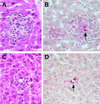Both Th1 and Th2 cytokines affect the ability of monoclonal antibodies to protect mice against Cryptococcus neoformans
- PMID: 11553589
- PMCID: PMC98780
- DOI: 10.1128/IAI.69.10.6445-6455.2001
Both Th1 and Th2 cytokines affect the ability of monoclonal antibodies to protect mice against Cryptococcus neoformans
Abstract
Variable-region-identical mouse immunoglobulin G1 (IgG1), IgG2b, and IgG2a monoclonal antibodies to the capsular polysaccharide of Cryptococcus neoformans prolong the lives of mice infected with this fungus, while IgG3 is either not protective or enhances infection. CD4+ T cells are required for IgG1-mediated protection, and CD8+ T cells are required for IgG3-mediated enhancement. Gamma interferon is required for both effects. These findings revealed that T cells and cytokines play a role in the modulation of cryptococcal infection by antibodies and suggested that it was important to more fully define the cytokine requirements of each of the antibody isotypes. We therefore investigated the efficacy of passively administered variable-region-identical IgG1, IgG2a, IgG2b, and IgG3 monoclonal antibodies against intravenous infection with C. neoformans in mice genetically deficient in interleukin-12 (IL-12), IL-6, IL-4, or IL-10, as well as in the parental C57BL/6J strain. The relative inherent susceptibilities of these mouse strains to C. neoformans were as follows: IL-12(-/-) > IL-6(-/-) > C57BL/6J approximately IL-4(-/-) >> IL-10(-/-). This is consistent with the notion that a Th1 response is necessary for natural immunity against cryptococcal infection. However, none of the IgG isotypes prolonged survival in IL-12(-/-), IL-6(-/-), or IL-4(-/-) mice, and all isotypes significantly enhanced infection in IL-10(-/-) mice. These results indicate that passive antibody-mediated protection against C. neoformans requires both Th1- and Th2-associated cytokines and reveal the complexity of the mechanisms through which antibodies modulate infection with this organism.
Figures







References
-
- Allen J E, Maizels R M. Th1-Th2: reliable paradigm or dangerous dogma? Immunol Today. 1997;18:387–392. - PubMed
-
- Banchereau J. Converging and diverging properties of human interleukin-4 and interleukin-10. Behring Inst Mitt. 1995;96:58–77. - PubMed
-
- Berger S, Ballo H, Stutte H J. Immune complex-induced interleukin-6, interleukin-10 and prostaglandin secretion by human monocytes: a network of pro- and anti-inflammatory cytokines dependent on the antigen:antibody ratio. Eur J Immunol. 1996;26:1297–1301. - PubMed
-
- Berger S, Chandra R, Ballo H, Hildenbrand R, Stutte H J. Immune complexes are potent inhibitors of interleukin-12 secretion by human monocytes. Eur J Immunol. 1997;27:2994–3000. - PubMed
Publication types
MeSH terms
Substances
Grants and funding
LinkOut - more resources
Full Text Sources
Molecular Biology Databases
Research Materials

